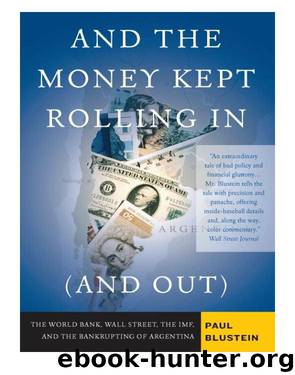And the Money Kept Rolling In (and Out) Wall Street, the IMF, and the Bankrupting of Argentina by Paul Blustein

Author:Paul Blustein [Blustein, Paul]
Language: eng
Format: epub
Publisher: PublicAffairs
Published: 2011-04-12T17:00:00+00:00
The argument fell on deaf ears. If it had been a mistake to give Argentina the first IMF loan, that mistake was about to be repeated in spades.
[ CHAPTER 7 ]
Doubling a Losing Bet
HEADS OF STATE meeting lower-ranking officials from other countries usually stick to pleasantries and generalities rather than delving into the nitty-gritty of policy disputes or negotiations, and that was the pattern at the Casa Rosada on August 3, 2001, when Fernando de la Rúa welcomed John Taylor, the U.S. undersecretary of the Treasury for international affairs, who was on a hastily arranged visit to Buenos Aires. The Argentine president talked about his country’s history and culture and its friendship with the United States. But there was no mistaking the meaning of the soulful appeal he delivered to Taylor: “I am looking at the man who holds the fate of my country in his hands.”
Seven months had passed since the agreement for the blindaje. Of the $14 billion that Argentina was to borrow under that program, the Fund had disbursed $6 billion, with the rest scheduled for disbursement later in 2001 and in 2002. Now the Argentine government wanted an “augmentation”—a new IMF loan of up to $8 billion, above and beyond the $14 billion—and it wanted the money pronto.
The country’s economy was in its deepest hole yet. Throughout July, following the announcement of the zero-deficit law on July 10 and more indicators of falling production and sales, riesgo país hovered in the 1,400 to 1,600 range, corresponding to borrowing rates for the government of about 19 to 22 percent. Although the government was not raising money from private investors at that stage, the high yields demanded by the markets were sending a relentlessly pessimistic message about the country’s chances for escaping its trap, and they were driving up interest costs for Argentine businesses to new highs. The most urgent problem was in the banking system, where $5 billion in deposits, about 7 percent of the total, flowed out of the banks in July—not a full-blown run but plenty worrisome. Much of this activity, which was conducted by corporations and large investors rather than small retail depositors, involved converting pesos into dollars and moving the money abroad. This meant that the central bank’s reserves of dollars were also dwindling fast; at the time of Taylor’s August 3 visit, reserves totaled $20.4 billion, down from $28.8 billion at the beginning of July. At that rate of decline, convertibility was facing a serious threat, because the system required an ample cushion of reserves to cover the supply of pesos. Accordingly, the de la Rúa government was seeking aid from the IMF with the aim of halting the withdrawals from the banks and reversing the decline in reserves. The plan was to deposit the money in the central bank, thereby replenishing reserves and delivering a reassuring message that the supply of cash in the banking system was ample to accommodate all comers.
The stage was being set for another IMF rescue that
Download
This site does not store any files on its server. We only index and link to content provided by other sites. Please contact the content providers to delete copyright contents if any and email us, we'll remove relevant links or contents immediately.
International Integration of the Brazilian Economy by Elias C. Grivoyannis(90873)
The Radium Girls by Kate Moore(11921)
Turbulence by E. J. Noyes(7935)
Nudge - Improving Decisions about Health, Wealth, and Happiness by Thaler Sunstein(7615)
The Black Swan by Nassim Nicholas Taleb(7010)
Rich Dad Poor Dad by Robert T. Kiyosaki(6401)
Pioneering Portfolio Management by David F. Swensen(6226)
Man-made Catastrophes and Risk Information Concealment by Dmitry Chernov & Didier Sornette(5921)
Zero to One by Peter Thiel(5685)
Secrecy World by Jake Bernstein(4644)
Millionaire: The Philanderer, Gambler, and Duelist Who Invented Modern Finance by Janet Gleeson(4374)
The Age of Surveillance Capitalism by Shoshana Zuboff(4209)
Skin in the Game by Nassim Nicholas Taleb(4161)
Bullshit Jobs by David Graeber(4094)
The Money Culture by Michael Lewis(4076)
Skin in the Game: Hidden Asymmetries in Daily Life by Nassim Nicholas Taleb(3929)
The Dhandho Investor by Mohnish Pabrai(3699)
The Wisdom of Finance by Mihir Desai(3651)
Blockchain Basics by Daniel Drescher(3507)
